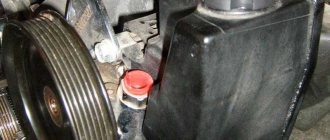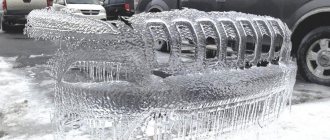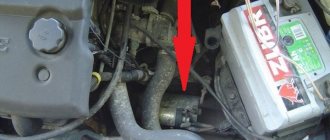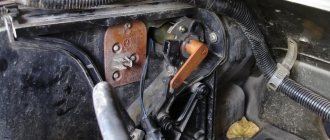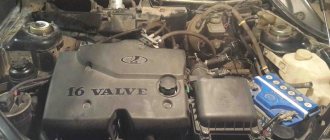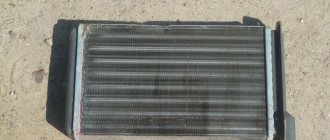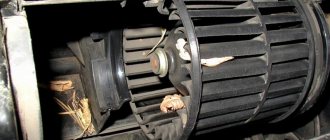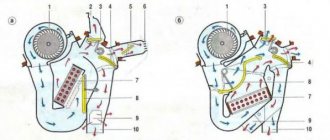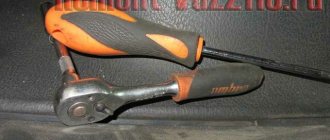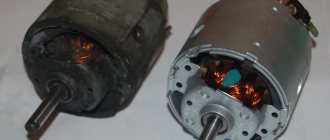The onset of winter for car owners is indicated not only by worsening weather conditions and a decrease in ride quality, but also by problems with the stove. Which of us remembers the heater of our VAZ in the summer? In the spring the stove turns off and it only gets to work in the fall. And this is where problems begin, for example, the interior does not warm up well or, in general, cold air blows from the VAZ-2112 stove. Before contacting a car service, you can try to figure out this problem yourself. It’s not that difficult, believe me, many problems with the VAZ-2112 heater can be eliminated with minimal effort and expense.
Most problems with the VAZ-2112 heater can be fixed yourself
VAZ-2112 owners need to know about some differences that are typical for the heating system. An important point is the separate operating principle. The heater design consists of a stove that prepares warm air to enter the cabin. The pipes are distributors of heated air. Thanks to the air ducts, heat comes from the control panel, is directed to the windows and blows on the feet. The heating system is controlled by a control unit. The heater design also includes an evaporator.
Why does the VAZ-2112 stove 8 and 16 valves not heat up and how to repair it
With all the great love for VAZ cars, drivers understand that, despite minor features in the operation of various car systems, their generation is still significantly different.
The uniqueness of the VAZ-2112 is manifested even in the heating system, which is not similar to its predecessors (except perhaps for the model above 2110). Accordingly, this also affects the features of the repair. Why the stove in the VAZ-2112 does not heat and how to repair it correctly and efficiently is not always easy to say. Before you begin repair work, you need to understand (at least superficially) how the heating system inside the car works. It is completely electronic, which makes its function more convenient, but at the same time difficult to repair. Now the stove has three regulators that help the driver choose the temperature of the desired heating and the direction of warm air (to the feet, for example). The point is that there is a sensor on top of the cabin that regulates the air supply (by an internal damper in the stove), depending on the reaction to the temperature. This is a very complex design, so without some knowledge in electrical engineering it is difficult to carry out repair work on your own. Not because replacing parts will be problematic. This part won't cause much difficulty. But it will be difficult to establish the source of the problem and find out why the stove does not heat as it should without a tester and an understanding of how the wiring in the car works. The only way to proceed in this case is to replace all the parts one by one in the hope that the problem will go away.
The stove does not heat: reasons, repairs
- A common cause of failure may be that the damper in the ceiling panel does not move (or moves weakly, not completely). This means that the temperature sensor has failed and needs to be replaced.
- Additionally, as with any vehicle electronics, a wiring problem cannot be ruled out.
- It often happens that the damper operates with some noise, and a striking effect is also noticed: the radiator is hot, the water in it is already boiling, but the air still does not become warm.
- In addition, it can run idle: there is work, but there is no result in adjusting the air.
This indicates that the damper is broken. Gluing the flap together is not difficult, but getting to it is not the easiest task.
To be able to remove it from the housing, you need to disassemble the heater. In general, there are two dampers: one blocks the flow of cold air (when required) and controls its flow as a whole, and the other regulates the air supply directly from the stove.
Let's sum it up
The high-quality functioning of the heating system of a vehicle is the main factor that affects the comfort and convenience of the interior. Problems with its operation during the cold winter periods force drivers to carry out urgent repairs and checks of the heating system.
There can be many reasons why the VAZ-2110 stove does not work or does not heat well. The main thing is to understand the technical features of the car’s heating system in order to narrow down the search for a fault as much as possible. Almost all dozens of causes of poor-quality interior heating can be eliminated with your own hands without significant financial investments.
To prevent heater breakdowns at inopportune times, monitor the car’s heating system and carry out regular preventive inspections and diagnostics. Experts recommend diagnosing the vehicle heating system at least twice a year. Only proper operation of the heater and constant high-quality care of it will guarantee its uninterrupted operation at any time of the year.
Other causes of failure
- In addition to the dampers, the fan often starts to malfunction. Possessing as many as four operating modes, its malfunctions can be very different. The first thing you need to do is look at the fuse (F7). If the fan refuses to work at all, most likely this is the problem.
- There are times when the above-mentioned unit performs poorly or even stops rotating at low speeds. This problem is more complicated, since, most likely, it is associated with the burnout of additional resistance. This is not that difficult to fix, but the problem will be the path to solving such a problem. The broken part can only be reached through the engine compartment.
- In addition, it is in the engine compartment that you often need to look for the reasons why only warm air comes out, while the adjustment is at the “maximum” position. It's all about adjusting and supplying air inside the car body. The climatic conditions outside the car are also important to consider. But it’s better to leave all the troubles with the engine compartment in the hands of the service station. Repairing heaters, stoves, and air circulation in this machine is very difficult, so independent work must be carried out with a great understanding of responsibility and good experience in machine repairs.
Otherwise, when the VAZ-2112’s heater does not heat up, it is better to immediately contact either the insurance service or a private service station. Taking into account the reasons described above, the driver will know exactly what will be done with his car, and may not be afraid of additional markups. The cause of a malfunction always lies in small details and simple parts, since they are often made from inexpensive materials that tend to break. You can’t rush to get into the wilds of the car. First you need to think wisely about what to do, and only then begin the difficult repair of the VAZ-2112 heating system.
Problems with the VAZ 2112 stove and its repair
The design of the VAZ 2112 stove heater differs from the previous VAZ-2108, 2109 family. When the engine is running, the radiator temperature should correspond to the general temperature of the cooling system. This means that the damper is always open and the supply of antifreeze (antifreeze) does not stop. The control system is electrical; processes are controlled by electronic sensors and controllers.
The center console has two control levers and one regulator. The driver, as necessary, sets the air temperature in the cabin, activates the desired mode (speed) of the fan, and directs the air flow to heat the glass and legs. A special electric thermometer installed in the ceiling controls the temperature. As soon as the temperature drops, the controller transmits a signal to the micromotor reducer, the heater is activated, and a flow of warm air enters the cabin. A malfunction of one or more units causes a breakdown, the VAZ 2112 stove does not heat well, and prompt repairs are required.
Blowing cold air - inspection of the heater radiator and cooling system
The radiator of the VAZ-2110 stove also does not have high heat transfer, and besides, it is quite difficult to get to it. However, it may be associated with a weak interior heating temperature:
- The heater radiator is clogged. If antifreeze does not get into it when the cooling system is in full working order, then it will not heat. Diagnosing a clogged stove is difficult, but it is possible. With the engine fully warmed up and the heater on, we feel the temperature of the radiator inlet and outlet pipes by touch. If the inlet is hot and the outlet is cold, the heater radiator is clogged. Few people clean it; the public prefers to buy a new one. The market will allow you to choose several models of aluminum radiators and one or two copper ones at our discretion.
The problem of radiator obstruction is solved either by flushing using special liquids, or by replacing the element.
- Cabin filter. If the cabin filter is clogged, there is no need to talk about air supply to the cabin. We take out the filter, check its condition and change it if necessary. In winter you can do without it. Diagnostics is simple - if the temperature in the cabin returns to normal when the filter is removed, that is the problem.
It wouldn't hurt to check the cabin filter as well.
- Thermostat. Often there is a problem with the thermostat. Its valve refuses to allow antifreeze to flow into the heater circuit, so the radiator is left without liquid. The only cure is to replace the thermostat.
Checking the thermostat.
- Heater radiator leaking. A clear symptom of a malfunction is antifreeze in the cabin and a drop in the level in the expansion tank. Only replacing the heater radiator will help.
If the radiator leaks, you will have to dismantle it and replace it with a new one.
- Airlock. One of the most common problems with the cooling system and heater is an air lock. As a result, the circulation of antifreeze is disrupted and the stove does not warm up completely or does not heat up at all. The air plug is removed by releasing some of the liquid along with air from the very top of the engine - from the throttle block fitting while the engine is running. After removing the plug, the stove should restore functionality.
The device of the VAZ 2112 stove
Heater parts
- electro-pneumatic valve;
- front housing;
- water deflector;
- control valve;
- back of the case;
- radiator;
- radiator casing;
- lid;
- resistor;
- Electrical engine.
Heater ducts and controls
- Rear heating ducts.
- Plastic lining of the tunnel.
- Foot heating channels.
- Ventilation nozzles of the central part.
- Side nozzles.
- Heated front doors.
- Mechanical heating lever.
- Distributor housing.
- Damper for heating feet, windshield.
- Heater.
It is important to know. Differences in the design of the old and new VAZ 2112 in the shape of the heater radiator, the SAUO controller, and the micro-gearbox. Conventionally divided before 2004 and after. When purchasing, be careful not to hand over unnecessary parts.
From the above it follows that the heating system of the VAZ 2112 operates separately. The VAZ 2112 stove pumps air at the required temperature into the cabin. The pipes supply flow to heat the windshield, passengers' feet, and rear row of seats. Deformation of the dampers and deflectors creates an obstacle to the air flow, so the stove does not blow well and requires diagnostics.
Advice from auto mechanics
To tune the VAZ heating system, its circuit diagram is studied. The system can be modified to block the air flow to the rear of the car using foam. The factory thermostat is also being replaced with an analogue one with 6 holes. In this case, the temperature in the cabin will remain longer, and the stove will heat better. Another way to modify the standard 2110 heating system is to install a plug for the deflector.
In order for the stove to serve longer, it is recommended to follow the rules of its operation.
If your car has air conditioning, it should only be turned on in wet weather. In winter, the stove turns on and directs the air onto your feet or onto the glass.
To ensure good operation of the heater, the nozzle is raised above the lining. Before starting the stove in winter, it is recommended to clean the glass from moisture.
Characteristic symptoms of malfunctions
In practice, there are five most common signs:
- The VAZ 2112 heater does not work, it constantly rotates at one stable speed;
- Temperature is not adjustable;
- The air flow control flaps are fixed and cannot be adjusted;
- Sensor - regulator on the ceiling is in a faulty state;
- Unstable operation of the ACS controller (automatic heater control system)
- Antifreeze leaking from under the radiator.
The list is not exhaustive, but only indicates the main malfunctions of the VAZ 2112 stove. Prevention will require a visit to a service station followed by diagnostics.
Causes of breakdowns
- violation of the terms of scheduled technical inspection;
- installation of non-original parts, components, consumables;
- filling the cooling system with antifreeze (antifreeze) of low quality or with chemical impurities, the quantitative composition of which exceeds permissible standards;
- mechanical damage to the fluid supply line, accident, collision, impact, violation of installation technology;
- short circuit in the network, electrical circuit, which contributed to the failure of the controller, sensors, resistors;
- damage to the damper control lever, malfunction of the dampers;
- poor terminal contact;
- damage to electrical wiring and cable sections.
Trouble-shooting
Checking the cabin air temperature sensor
You can check the serviceability yourself; special skills are not required. Carefully remove the sensor from its original place. We find the contacts on the back side. Using a multimeter, apply a voltage of 1.2V. We set the regulators of the automatic heater control system to the “Min”, “Max” positions. The motor should not be activated.
The second method is to turn off the cabin air sensor. Check fan speed settings. The first speed (“A”) should be inactive.
Video: Heater VAZ 2110, 11, 12. Design and principle of operation.
Checking the proper operation of the automatic control system
The proper operation is checked with a multimeter. The voltage at the terminals of the pink and brown wires is measured, the ignition is activated. Smoothly turn the temperature regulator; the arrow on the multimeter display should show an increase in voltage.
Why does the VAZ-2112 stove heat poorly and how to fix it
If the stove on your VAZ-2112 does not heat well, do not be upset - this problem is common to many domestic cars.
In winter, when your feet are cold inside and your hands are freezing, this, of course, will make few people happy, but almost any malfunction associated with stove repair can be repaired. It is difficult to say unequivocally why this happens, since everything has its own reasons that need to be found and eliminated. The design of the VAZ-2112 stove (16 valves) is quite simple and consists of two elements. One of them is that the heater is installed under the hood of the car and must heat the air, which is supplied to the cabin at a certain speed. The second one is the air distributor. To eliminate the cause of poor heating of the stove on the VAZ-2112, you need to figure out which one is not working correctly.
Refinement of the plastic block
If the stove blows weakly into your feet, then the reason is the plastic heater control unit of the VAZ-2110. Before starting repairs, it is recommended to make sure that the stove is in working order. Then you will need:
- dismantle and disassemble the torpedo;
- seal the cracks on the panel;
- install a new corrugation;
- seal the panel.
During the factory assembly of the car, the damper is poorly pressed against the dashboard, which contributes to the loss of hot air in the instrument panel. This problem can be solved by removing the damper and the standard seal. We treat the cracks and the valve with madeleine. The factory sponge is replaced with Bitoplast-10. To prevent the passenger's feet from freezing, the air ducts are being modernized.
Another heat loss problem is related to cracks near the driver's seat. They can be blown out with foam. If necessary, replace the old-style air distributor. We place a pipe with a diameter of 40 mm in each hole. If the unit works correctly, then the heating scheme is as follows: from one corrugation warm air flows to the driver’s feet, and from 2 and 3 to the passengers’ feet. There should be no holes between the pipes. If you completely remove the air ducts, hot air will flow into the cabin.
Causes of poor heating
The reasons for insufficient heating vary. The most common of them is an insufficient amount of antifreeze in the engine cooling system. To determine the amount of coolant, you need to check the expansion tank and add antifreeze to the level if necessary. The next significant reason may be hidden in the heater core. Often a crack or small hole appears in the radiator, which affects the quality of its operation.
An air lock is another problem that prevents the radiator from fully performing its functions. You can try to eliminate it. To do this, you need to drive your front wheels onto a hill and stand for several minutes with the engine running at medium speed. In some cases, simply replacing the cabin filter is enough. The reasons, as you can see, can be different; some will take a few minutes to eliminate, while others sometimes take half a day. But let's look at what needs to be done if the stove does not heat well.
Mayevsky crane
Design of the Mayevsky crane
It is designed to eliminate air lock in the heating battery. Despite its small size, the Mayevsky faucet helps to effectively remove accumulated steam not only in radiators, but also in pipes.
Structurally, it is a needle valve enclosed in a metal housing. How to remove an air lock from a heating system using it? First you need to decide on the device model.
Manual taps
After installation in the upper radiator pipe, air is released after turning the union nut on the tap. Removing an air lock from the heating system using a Mayevsky manual tap is carried out according to the following scheme:
- Filling the system with coolant. The taps on the radiators are closed;
- When the maximum level is reached, the water supply stops;
- Having set the required gap of the needle limiter in the devices, the taps are opened;
- At the same time, the coolant supply is restored.
Water is added to the system until liquid begins to flow from all Mayevsky taps. Be sure to check that there is no air flow. This method is effective for removing air locks in heating radiators when starting the system for the first time, before the season, or when airiness appears during operation.
Manual models will effectively eliminate air lock in the radiator for both autonomous and central heating. The main thing is to choose the right mounting thread. In most cases it is 1/2", but there are models with a non-standard size of 3/4".
Automatic taps
Mayevsky automatic crane
Unlike the model described above, in their design, a seat with a certain surface area is installed on the end of the needle valve. In combination with a return spring, the degree of pressure of which determines the critical pressure value at which the valve opens. A detailed device is designed to automatically break through a heating plug when a critical temperature value and, as a result, pressure is exceeded.
However, before installation you should familiarize yourself with the specifics of this model:
- To prevent water from getting onto the floor, the structure must have a pipe to drain excess water into the sewer;
- If it sits for a long time, the valve seat may become covered with limescale, which will make it difficult to open. Therefore, it is recommended to open the tap manually once every 2-3 months. The steps of the procedure must be done before starting the heating for the first time;
- The set maximum opening pressure should not exceed the critical pressure of the entire system. In order to remove an air lock from the heating in automatic mode, the pressure value on the tap should be 5-10% less than the maximum.
What is better to install: an automatic or manual Mayevsky crane? If the operation of the system does not involve sudden pressure surges, manual models can be installed on the radiators. For autonomous heating, preference is given to automatic ones.
It is best to choose models made of brass. During the expulsion of an air lock from the heating, they can withstand not only a critical pressure value, but also a temperature. The steel body is subject to destruction and rusting.
temperature sensor
You can often encounter the following problem: it is not possible to properly regulate the temperature in the cabin. In most cases, the problem is a failure of the control unit and an incorrectly set damper. This is not a difficult problem at all, and it can be solved quickly. First you need to check the serviceability of the temperature sensor. To do this, move the heater knob to one side, and after a while - to the other. The temperature of the air entering the cabin should change. If this happens, the problem is not in the controller. If the temperature sensor does not work, you can temporarily turn on the stove without it, then the temperature in the cabin will be the same as that set on the electronic unit.
Poor heating at idle
If you suddenly experience a flow of cold air while the engine is warm and the heater is on, there are probably problems with the thermostat or pump. The cause of this phenomenon may be a damaged cylinder head gasket. A broken gasket gives the effect of an airy state. But this is not the worst situation, it is much worse if the reason why the stove does not heat well is a non-working pump.
A failed pump will not circulate coolant, causing the engine to overheat. So if the heater on your car begins to heat worse, you need to check the performance of the pump. A faulty heater valve also affects the flow of warm air into the car interior. If it stops working normally, the inlet hose will be hot and the outlet hose will be cold.
What to do first
In order not to get buried in the abundance of reasons, it is necessary to act from simple to complex. Leave the frightening thoughts of a broken cylinder head gasket and take a trifling attitude, as if the electric damper actuator has failed. Actually, that's where we'll start.
Check the operation of the climate control shutters
Turn the knob or rocker of the climate system and evaluate the temperature of the incoming air. For example, with “blue all the way” the air should be noticeably cold, and with the maximum red settings it should be warmer.
Immobilized valves will not be able to mix flows according to the specified °C value. Therefore, at any position of the regulator, air will blow at the same temperature. The dampers stop as a result of damaged fasteners or a failed servomotor.
Is the antifreeze level in the expansion tank stable?
Lift the hood, find the “extender” and the boundary marks on it. When cold, the antifreeze level should be between the MIN and MAX marks. If the tank is constantly emptying, look for leaks. You can look at where the coolant goes using the Lada Vesta as an example.
Heater radiators of some cars, for example Lada Kalina, are very sensitive to the amount of antifreeze in the expansion tank. At the slightest leak, the engine heats up, and the stove is cold or barely warm. And in general, when liquid flows out, air comes in and thus the system becomes airy.
Inspect the heater radiator for unobstructed circulation
Find two pipes going to the heater heat exchanger near the engine shield and touch them. The radiator assembly is embedded in a small circle in parallel, which means that the hoses should warm up immediately after starting the engine. It is better to carry out work when the engine is warmed up.
How to remove an air lock without draining the coolant
It happens that if there is air in a small circuit, the temperature sensor on the dashboard behaves strangely: the needle sometimes jumps. For example, it was at 60°C and instantly became 90-100°C, then returned back. This is explained by the fact that the air heats up noticeably faster than the liquid and to higher temperatures. As a rule, the needle twitches when the system is seriously aired.
The fact is that a small traffic jam does not always go around the entire small circle. Air accumulates at the highest point of the circuit - the radiator of the car furnace, causing the circulation of coolant in it to slow down. At the same time, there are no sudden temperature changes in the motor jacket. Even without observing extraneous symptoms, assume that the engine is overheating and the cabin heater is blowing cold air due to air accumulation. Try to etch it out, because you don’t need to disassemble anything:
- Raise the front end on a lift or drive up a hill.
- Allow air to escape through the highest point in the system. Why unscrew the cap of the expansion tank if it is a circulation tank (there is no plug on the engine radiator), or the cover of the engine heat exchanger. On front-wheel drive Ladas, the highest point is the throttle heating hose, disconnect it.
- Warm up the engine to operating temperature at idle speed.
- Increase the speed to 2,500-2,700 units.
How to easily remove a dirt plug from a furnace heat exchanger
When one side of the heater radiator is cold and the other is hot + no antifreeze is coming out, feel free to flush the heater radiator installation. There is no need to remove anything except the pipes. The only equipment that will be useful is a submersible pump from a country well, a deep basin, long hoses and one of the means for flushing the car engine cooling system.
Find out where the heat exchanger has the inlet and outlet and start cleaning:
- Disconnect the standard tubes. When dismantling the pipes, 1-1.5 liters will drain. coolant. A 2-3 liter coolant canister is quite enough to replenish reserves. There is no need to drain all the antifreeze from the system.
- Connect the hoses leading to the pump and basin: supply to the radiator outlet, drain to the inlet.
- Fill the container with cleaning agent.
- Turn on the pump for 10-15 seconds.
- Reconnect the hoses: supply - to the inlet of the heat exchanger, drain - to the outlet.
- Turn on the pump for 15-20 minutes.
- The flushing composition will circulate in a circular manner: from the basin and back into it.
- A short supply of fluid in the opposite direction quickly flushes out the dirt plug at the radiator inlet.
- Check whether antifreeze flows from the radiator steam pipes into the tank (relevant for circulation “expanders”).
Broken gear motor or heater
In almost all cases, a non-working gear motor is easier to replace. In order to release this element, it is necessary to remove the windshield wiper, “jabot” and unscrew the screws. After this, you need to remove all the wires going to the gearmotor, and then remove it too. Next, change the non-working element and adjust the air supply.
The heater malfunctions very rarely, but it should also be checked. To determine its condition, you need to dismantle the main deflector and also straighten the fasteners. Large amounts of scale or mechanical damage will indicate a non-functional condition.
Source
